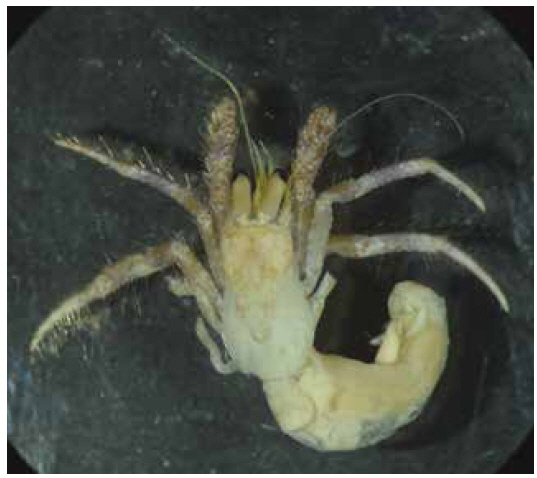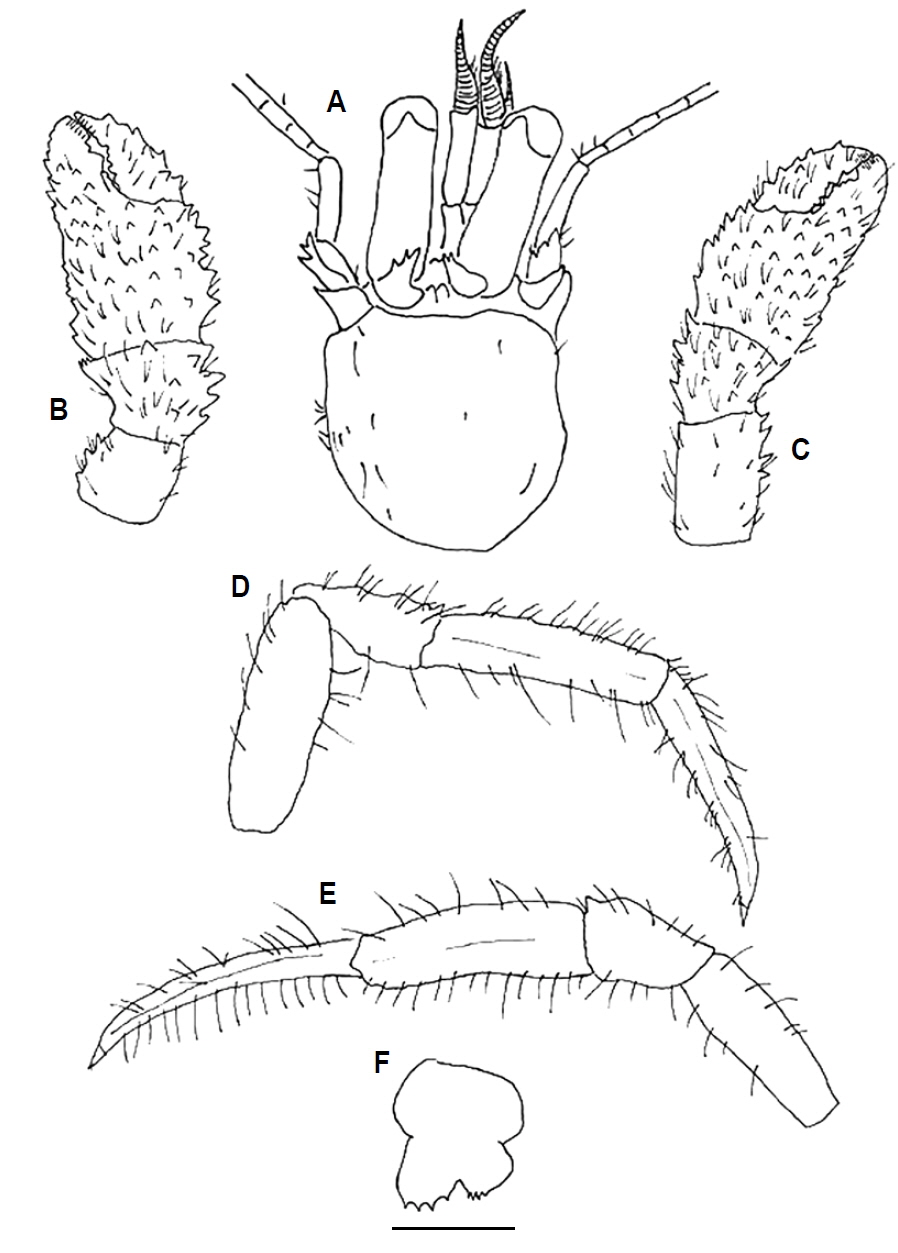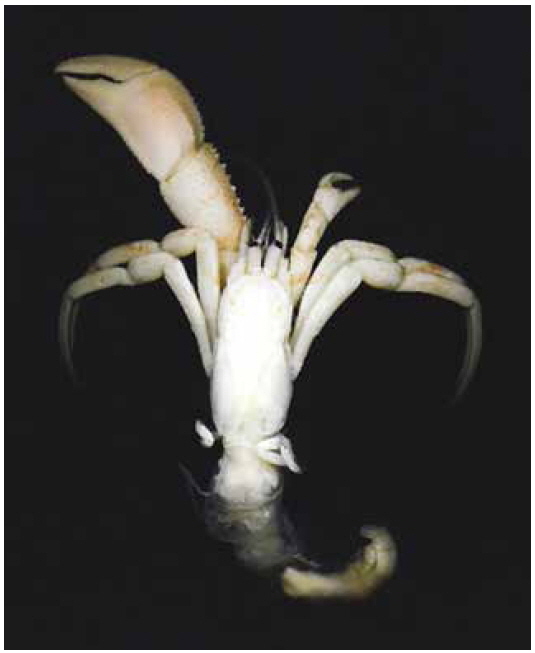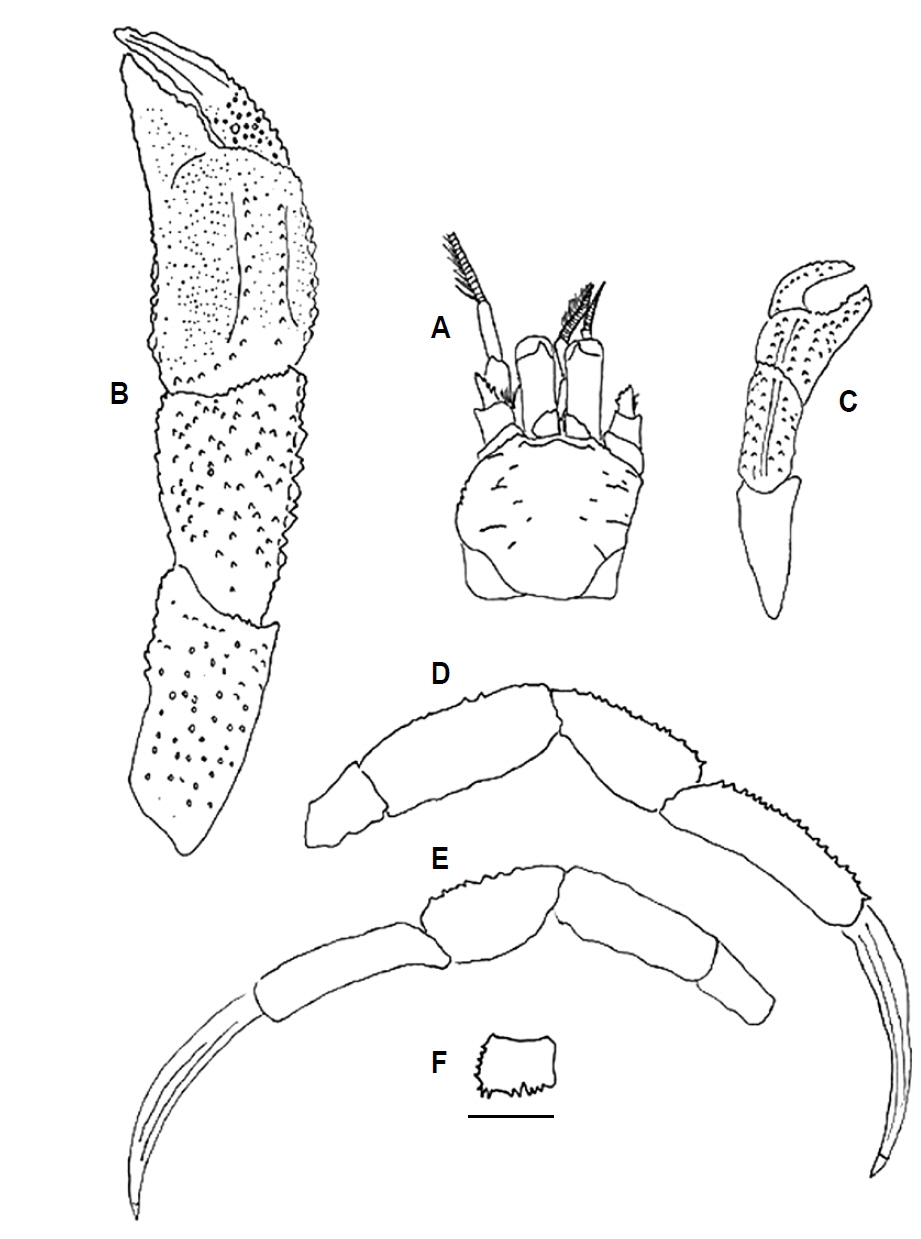



The family Diogenidae Ortmann, 1892 is one of the major taxa in the superfamily Paguroidea Latreille, 1802. Most genera of this family appear extensively near the equator in the Indo-Pacific region (McLaughlin et al., 2007). They are found in various habitats, from intertidal to slightly deep subtidal, and most species live in gastropod shells. Some species have formed a symbiotic relationship with anemones. Members of family Diogenidae are readily distinguished from other hermit crabs by their third maxillipeds, located close to each other in their bases. This family is also characterized by other characteristics: the left cheliped is generally larger than the right one, the antennular flagella terminating in a filament, no paired pleopods on the fourth and fifth abdominal somites, and the abdominal tergites mostly not well calcified (McLaughlin, 2003).
The family Diogenidae includes 20 genera and 429 species (McLaughlin et al., 2010). In Korea, only 6 genera and 18 species have been reported in this family:
All specimens were preserved in 99% ethanol and observed with a stereomicroscope (Leica MZ8; Leica, Wetzlar, Germany). Figures were drawn with a camera lucida on a Nikon SMZ800 (Nikon, Tokyo, Japan). Photos were taken with a digital camera (D200; Nikon) and assessed with the Helicon Focus software. The terminology follows McLaughlin et al. (2007). The abbreviation ‘sl’ refers to the shield length, measured from the end of the rostrum to the middle of the posterior margin of the shield, with digital slide calipers (Mitutoyo CD6CSX; Mitutoyo, Kawasaki, Japan) to 0.01 mm. The specimens examined in this study were deposited in the Marine Arthropod Depository Bank of Korea, Seoul National University (MADBK).
Order Decapoda Latreille, 1803
Superfamily Paguroidea Latreille, 1802
Family Diogenidae Ortmann, 1892
Genus
Material examined. 1♂ (sl 2.15 mm), Korea, Gyeongsangbuk-do, Ulleung-gun, Seo-myeon, Tonggumi, 15 Jul 2013, by SCUBA max 15 m, coll., Jung J, Park JH.
Description. Shield (Fig. 2A) almost as long as broad and with tufts of setae; rostrum almost absent. Lateral projection round, longer than rostrum. Ocular peduncle as long as shield; cornea somewhat dilated. Ocular acicle with 2 or 3 spines. Antennular peduncle not exceed distal corneal margin. Antennal peduncle shorter than ocular peduncle. Antennal acicle with several spines.
Left cheliped (Fig. 2B) not massive, slightly larger than right one, 2.3 times as long as shield; surface covered with long setae. Dorsal surface of chela with spines. Dactylus almost same length of palm measured along mesial margin; cutting edge with row of calcareous teeth, terminating in small corneous claw. Dorsal surface of palm with numerous scattered spines. Carpus 0.5 times as long as chela; dorsal surface with scattered spines. Merus slender. Right cheliped (Fig. 2C) 2.2 times as long as shield, similar to left cheliped.
Second and third pereopods slender and long, with tufts of long setae. Second pereopod (Fig. 2D) 1.4 times as long as left cheliped. Dactylus 1.1 times as long as propodus; lateral surface with median longitudinal groove. Propodus 1.9 times as long as carpus. Carpus 0.5 times as long as merus; dorsoproximal margin bearing 1 strong spine. Third pereopod (Fig. 2E) similar to second pereopod.
Abdomen twisted, male with 4 unpaired pleopods and 4 calcificated abdomen plates.
Telson (Fig. 2F) separated by narrow median cleft, asymmetrical, left lobe larger than right one. Posterior margins of 2 lobes, each with 4 spines.
Coloration. Shield white and mottled brown with old copper patch anteriorly. Ocular peduncle yellowish-brown. Pereopods white and mottled brown. Carpi of second and third pereopods old copper. Setae with cream tips.
Distribution. East Africa; Red Sea; Indian Ocean; Southeast Asia; Australia; Polynesia; Taiwan; Japan; Korea (Ulleung Is.).
Habitat. Living in a gastropod shell.
Remarks. This species is reported from Korean waters for the first time. It has been recorded from near the equator in the Indo-Pacific region. The present study extends the known range of this species northwardly. The specimen in this study was found living in the shell of a cone snail, occurring in the tropical area.
McLaughlin et al. (2007) noted that this species has two color forms, “red-knee” form and “blue-knee” form, which originated in the color of the carpi of the second and third pereopods. They also mentioned that chelipeds of
Genus
Material examined. 1♂ (sl 4.81 mm), Korea, Gangwon-do, Gosung-gun, Oho-ri, 27 Jul 2011, by SCUBA max 19 m, coll., Lee S.
Description. Shield (Fig. 4A) subquadrate, almost as long as broad; dorsal surface with transverse ridges with spine and tuft of setae laterally. Rostral lobe rounded, lateral projection bearing terminal spine. Intercalary rostral process long and slender, with acute tip. Ocular peduncle stout, 0.6 times as long as shield. Ocular acicle unarmed. Ultimate segment of antennular peduncle almost exceeding ocular peduncle. Antennal peduncle overreaching distal corneal margin. Flagella with long setae.
Left cheliped (Fig. 4B) larger than right one, 4.5 times as long as shield; most of the surface covered with small granules. Chela 2.1 times as long as broad; dorsomesial margin with strong tubercles. Dactylus curved, sharp, slightly longer than palm measured along mesial margin; dorsal surface depressed; ventral margin with groove; cutting edge with row of calcareous granules. Palm elongate; dorsal surface with 2 rows of tubercles; lateral margin convex, edge slightly depressed. Carpus with spinulose tubercles on dorsal surface. Merus depressed laterally; ventromesial margin with 3 moderately strong granules.
Right cheliped (Fig. 4C) reaching to middle of carpus of left cheliped; most surface with tuft of setae and rows of small tubercles. Chela 2.1 times as long as broad. Dactylus 1.5 times as long as palm; cutting edge without row of calcareous teeth. Palm not stout; dorsomesial margin with groove. Carpus 0.7 times as long as chela, strongly inflated ventrally; dorsomesial margin with rows of spinulose tubercles. Merus depressed laterally.
Second and third pereopods slender, covered with tuft of setae. Right second pereopod (Fig. 4D) reaching to base of dactylus of left cheliped. Dactylus 1.2 times as long as propodus, somewhat twisted; lateral margin with groove. Dorsal margin of propodus and carpus with rows of small spines. Merus depressed laterally.
Left third pereopod (Fig. 4E) similar to second pereopod but dorsal margin of propodus unarmed; in right pereopod row of spines present.
Abdomen twisted, with 4 unpaired pleopods in male.
Telson (Fig. 4F) separated by narrow median cleft, asymmetrical, left lobe larger than right one; left lobe with 9 strong spines laterally, 2 small spines mesially; right lobe with 3 small spines mesially.
Habitat. Living in a gastropod shell.
Distribution. Chinese coast from Bohai Sea to Hainan Island; intertidal to 30 m; Korea (East Sea).
Remarks. This species is reported from Korean waters for the first time. It has been only recorded in the Chinese coast, from Bohai Sea to Hainan Island (Wang and Tung, 1980; Komai et al., 2012). The present study extends the range of this species eastwardly.
The examined specimen shows two slightly different characteristics compared with the description by Komai et al. (2012). The outer surface of fixed finger of left cheliped bears a row of tubercles on an elevated midline in their specimen, but the present specimen does not; ocular acicle is armed with four or five spines in their specimen but the present specimen does not. Because other characteristics agree with those of their description, such differences are regarded as individual variation.





